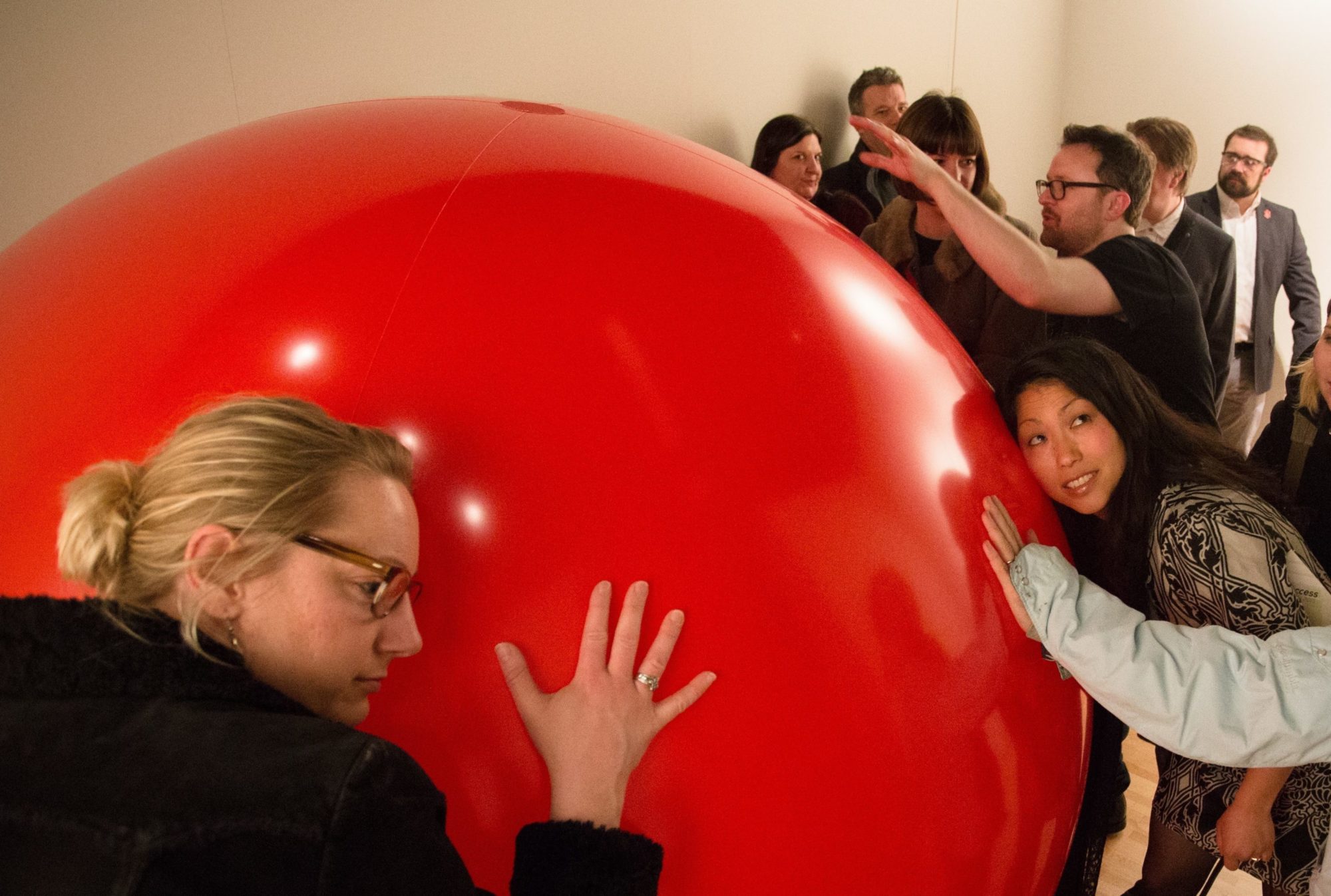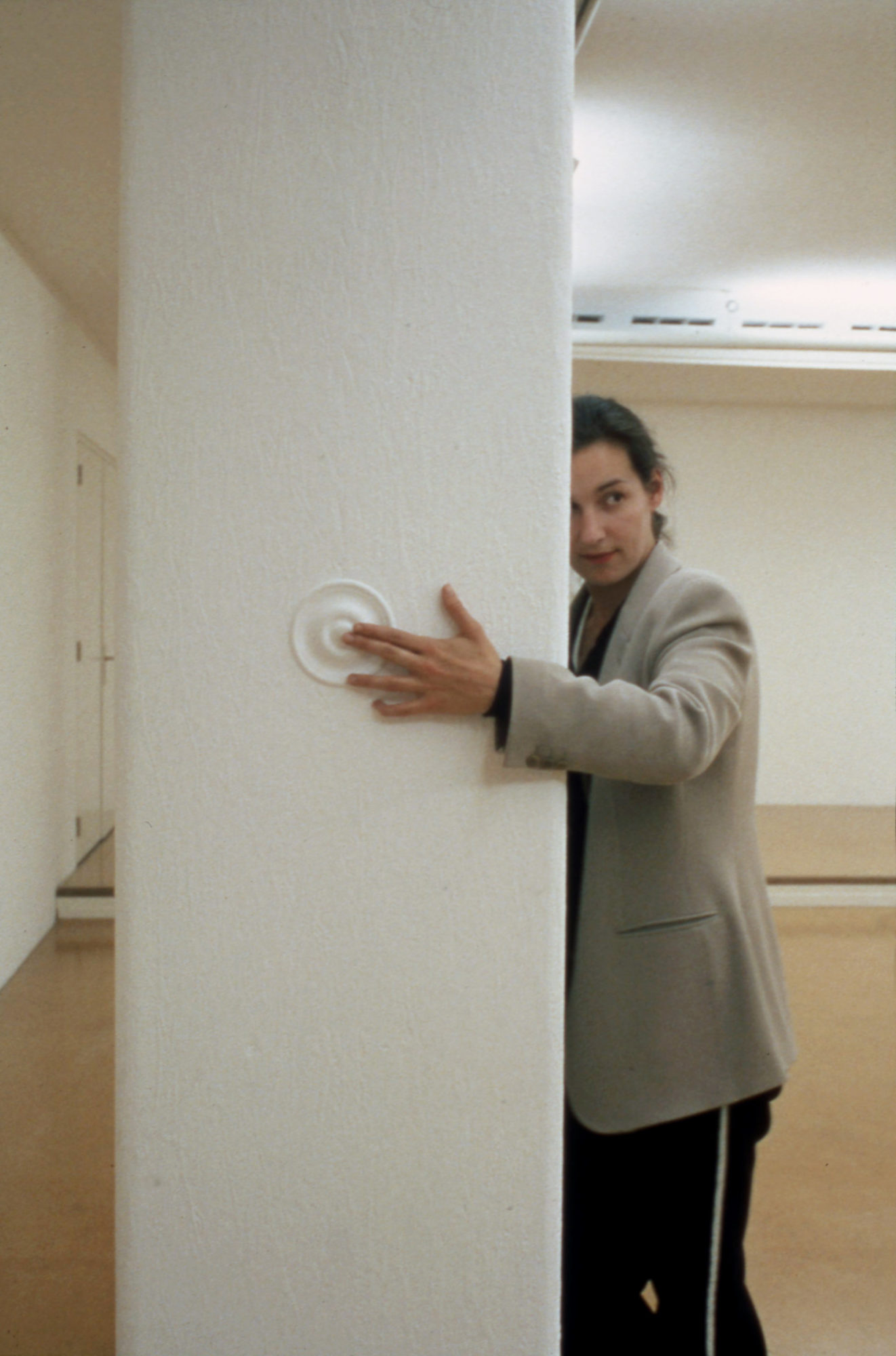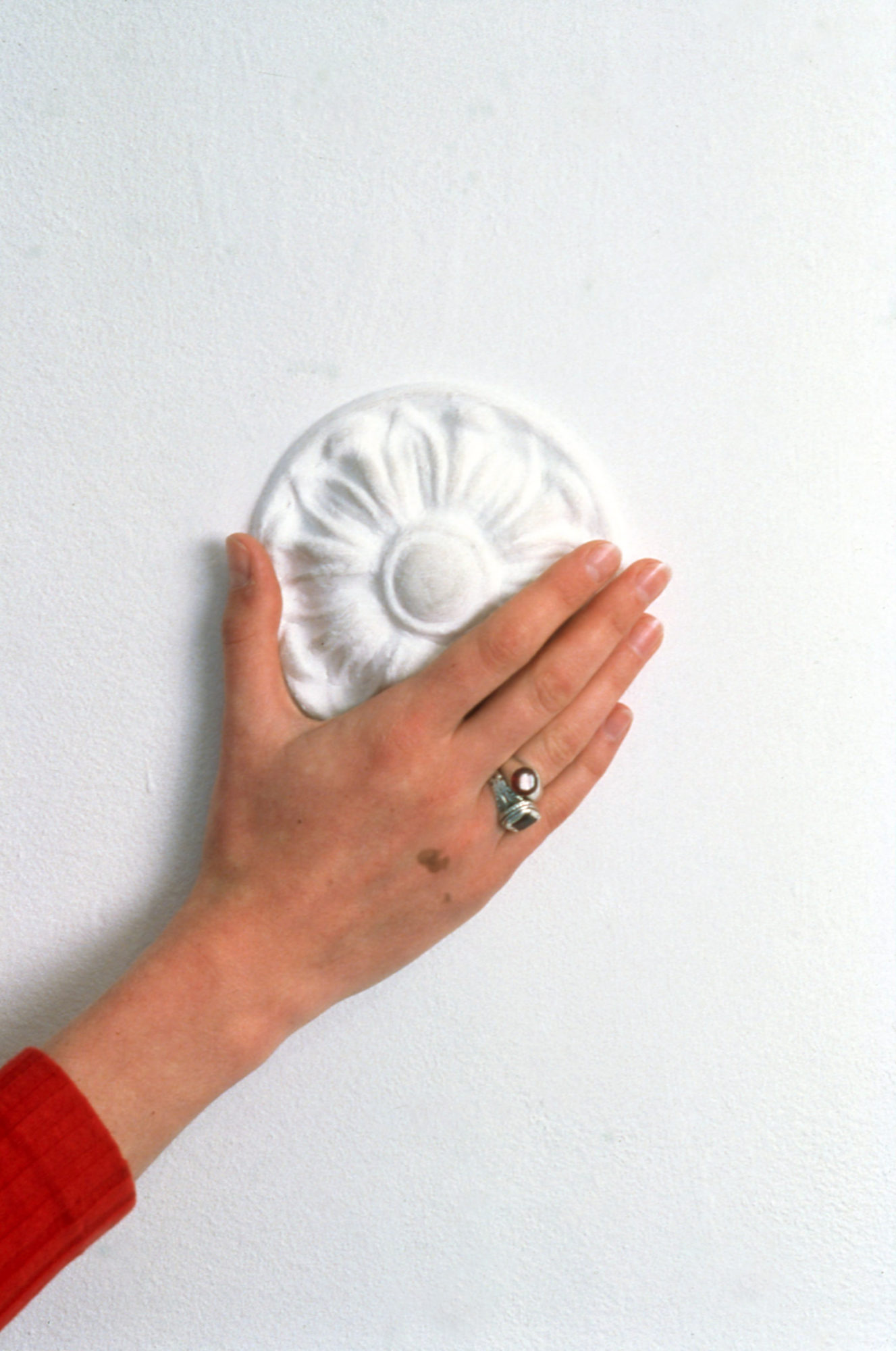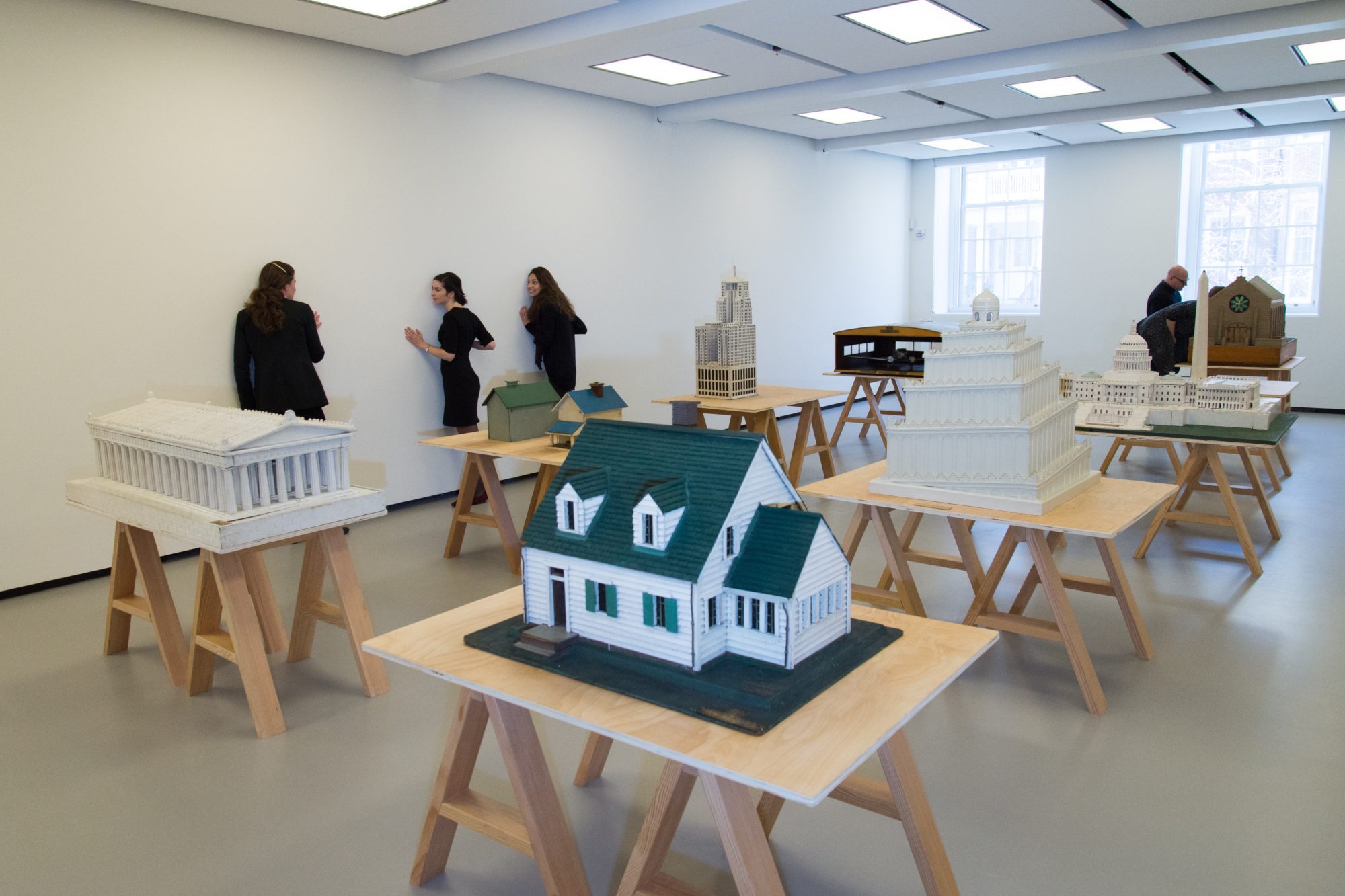Rethinking Sensory Dimensions

Wendy Jacob, Waves and Signs (jazz), installation view, 2015 [photo courtesy of Artist and Kendall College of Art and Design, Grand Rapids, Michigan]
Share:
American artist Wendy Jacob has been making and exhibiting work since 1988, always with a keen interest in the negotiation and understanding of architectural and domestic spaces. With work that expands the sensory dimensions of art, she invites the blind and hard of hearing to experience galleries and museums primarily through touch rather than sight and sound, subsequently subverting the able-bodied visitor’s expectations of the white cube, asking them to reconsider and reframe their point of view.
In 1993, for example, Jacob learned of Temple Grandin, an autistic woman and animal scientist who built a hug machine to help ease her hypersensitive nervous system. After their eventual meeting, Jacob made her first Squeeze Chair—a chair with inflatable arms to hold the sitter in a hug-like embrace. The same year that she became aware of Grandin, the artist debuted Rosette, a series in which she heats and isolates circular architectural elements on walls and columns. While the chairs have a chunky, sometimes floral aesthetic appeal, the rosettes are hardly visible. Visitors rely on physical interaction with the sculptural objects, rather than the appearance thereof, to experience and understand Jacob’s artistic intention. Emily McDermott spoke to Wendy Jacob about her long-standing interest in architectural and sensory experience.
Emily McDermott: To begin, I’m wondering what initially led you to the topics of architectural and domestic spaces and working in a way that expands art’s sensory dimensions?
Wendy Jacob: Moving to Chicago from Boston for graduate school changed a lot of things for me. Everything about the city felt big: distances, buildings, the lake, the wide sky. Somehow that bigness and the toughness of the city made it feel like a place where you could carry out projects that would be impossible in other places, so I decided to try to animate an inert object with the action of breathing. I wanted to make that object so all-encompassing that it would completely fill my vision and experience, so in 1989 I made a wall. It was my first architectural work and was constructed using a giant sheet of rubber, an old vacuum cleaner and a mechanical timer. I painted the moving surface white to match the rest of the walls. My father had recently died, and for me the wall’s motion echoed the rhythm of his breath while in a coma. I went on to install other breathing surfaces—walls, ceilings, columns—in many different spaces, and in each one, I had the challenge of how to engineer the work so it would fit seamlessly into that space. Invariably, the architecture became an important element in the work as well.
EM: But your work isn’t just about architecture. Interactivity has also always been an important cornerstone. When walls are animated to breathe, they enter the audience’s space. Visitors have also been invited to touch and sit on sculptural objects ….
WJ: I’m interested in how a body inhabits a room, a building, a public space, and how that experience is not just visual and aural but also tactile. You can see and hear from a distance, but touch requires physical contact, and hence interaction. Many of my works are meant to be touched by hand or ear or with your whole body, making the experience more immediate.
EM: To put it bluntly, how did this interest in space eventually give way to you, as an able-bodied person, collaborating with autistic, blind, and deaf people?
WJ: I never set out to work with disability per se. I kind of backed into it. Over the course of many years, my interests evolved from evoking breath to capturing the essence of an embrace to rendering vibration as a physical manifestation of sound. Along the way I collaborated with autistic individuals, and later with deaf students and a school for the blind. The process was really a meandering exploration with chance encounters and unplanned turns.
My interest in vibration, for example, was sparked in 2008 through my friend Hansel Bauman, an architect and teacher at Gallaudet University, a school for the deaf in DC. Hansel was directing an architecture studio at Gallaudet, exploring the shape and feel of space from the perspective of being deaf, while I was teaching Autism Studio at MIT. It seemed that we might learn something from each other, so the two studios met up in DC for two days of discussion and workshops. One of the things we explored was tactile sound, vibrations that you can “hear” with your body, such as knowing someone has entered a room because you can feel the vibrations of their footsteps traveling through the floor. The group from Gallaudet later came to MIT and we engineered and built a dance floor for a silent dance party. That initial meeting started a long relationship and triggered ideas that carry through to the work I am doing today.
Wendy Jacob, Column Rosettes, installation view, 1994 [photo: Mancia Bodmer; courtesy of artist and Galerie Walcheturm, Zurich]
Wendy Jacob, Rosettes, detail, 1993 [courtesy of artist and Galerie Jennifer Flay, Paris]
EM: I’m particularly interested in Rosette, because it seems to be the first time you worked with touch and heat. What led you to the rosette and the sense of touch?
WJ: I was experimenting with working on a smaller scale and it occurred to me that a small, warm dot might be an interesting alternative to a large breathing wall. The rosettes are made out of pressed tin, so they are also conduits for heat. I wired the circular decorative motifs with unseen electrical coils to keep them warmed to body temperature, because they’re supposed to be warm in a way that’s deeply familiar, like the warmth of a body is familiar. When a rosette is displayed on a wall, separate from other moldings, it looks like a misplaced doorbell. It also appears almost erotic. There is nothing that instructs visitors to touch it, but they do. And when they do, the rosette answers back with its warmth, as if it has been waiting to be touched. There are of course rules of etiquette that govern touch. Reaching out and touching a rosette in a museum is a minor trespass. Also, I don’t think the rosettes are so different from the breathing walls. With the walls I isolated breathing from the more complex and messy experience of being alive. With the rosettes, it’s warmth.
EM: This warmth, though, is felt through touch, whereas the walls relied upon hearing. What do you think the sense of touch brings to one’s understanding of the world?
WJ: I recently read about the wholesale markets in Paris in the centuries before the invention of gaslights. Merchants had to purchase their goods well before dawn in order to be ready when their shops opened. Because candles were expensive, merchants assessed goods and made their purchases in almost total darkness, relying on their senses of touch, smell, and taste to make discerning choices about freshness and quality. Although we tend to rely primarily on vision and sound for information, there is something elemental and direct—maybe even more truthful—about touch, smell and taste.
EM: Touch is also, of course, an important sense for the blind to understand the world and place themselves within their surroundings, and your 2016 exhibition Calm. Smoke rises vertically. at the Radcliffe Institute dealt very much with this topic. It included a wide range of scale models of buildings made for the blind. How did you first come across this collection of models?
WJ: Some years ago, I toured the Perkins School for the Blind near Boston. Near the end of the tour, I was taken to the school’s tactile museum, a modest basement room where many curious objects were on display. Besides a taxidermied shark, there were also scale models of the Parthenon, the Tower of Babel and a Catholic church. I learned that the models were made in the 1930s and 1940s, as part of a WPA project to provide educational materials for the blind.
Wendy Jacob, Smoke Rises Vertically, detail, 2016 [photo: Kevin Grady; courtesy of Artist and Radcliffe Institute, Boston]
EM: With an entire cabinet of curiosities, so to speak, of available material, why focus on the models? Why not include items like the taxidermied shark?
WJ: Without sight, it is hard to apprehend the size of anything larger than what you can touch. You can see a life-sized shark with your fingers, but how do you understand the size and proportions of something as huge as the US Capitol building? That’s why I focused on the models of buildings: they take you beyond the scale you can normally understand by touch. In using these models in the context of art, my interest is less about learning, and more about the immediate experience of seeing with your fingers.
EM: That reminds me of a tour I recently took of Berlin’s Reichstag building. They had two large models for blind visitors and in closing my eyes and feeling them, I gained an entirely different understanding of where I was and my scale in relation to the space than that which my eyesight provided. Having felt these structures, when I placed my hand on the cold stone walls, I could envision the building and how elements of its roof or turrets might feel or look, even though these places weren’t part of the tour.
WJ: Yes! At Radcliffe, in addition to installing the models, I activated the gallery walls to carry sound, turning them into giant speakers. Although the surfaces were large, the sound was barely audible, unless you put your ear directly to a wall. In this way the work operated on two scales, like your experience of the Reichstag and its two different scales.
EM: Some of the models are of mythological spaces like the Tower of Babel, which has been rendered in various drawings, sculptures and other forms, but is nonetheless imaginary. In giving someone a model of this structure, you could be seen as defining something that should remain in flux. Did you think about this when selecting the buildings to include?
WJ: It never occurred to me to distinguish between real and imaginary buildings, and in any case, the initial selection was made by the WPA, not by me. The WPA surveyed students and teachers at schools for the blind to find out what they most wanted to see. The result is this eclectic array of buildings ranging from the Washington Monument to a Cape Cod cottage to the Tower of Babel. The latter conforms to its creator’s ideal vision of the tower, just like any painting or other rendering of an imaginary object. This particular tower is cubic, unlike Bruegel’s more conic version.
EM: Speaking more generally, in relation to your entire oeuvre, I’m curious whether or not you see your work as a kind of activism for accessibility and disability?
WJ: I don’t think of myself as an activist. I see myself, in some ways, as expanding a dialogue and an exploration without directing where it will go. It’s about the joy and pleasure of working with objects, space, and people.
This exchange has been edited and amplified for publication, and originally appeared in ART PAPERS “Disability + Visibility,” Winter 2018/2019.
Wendy Jacob is an artist. She lives in Cambridge, Massachusetts. Emily McDermott is a writer and editor. She lives in Berlin.


